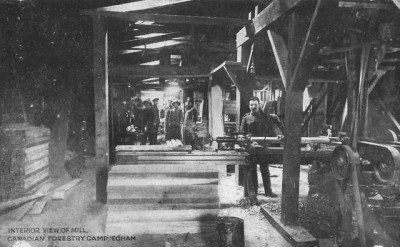Canadian Foresters in Egham
 During the First World War Germany waged a campaign of submarine warfare against Britain designed to undermine it’s capacity to continue the fight on the Western Front and force it to sue for peace. In response to the increasing pressure on its shipping the British government looked for ways to reduce the amount of timber it had to import from overseas. Prior to the war Britain produced only 900,000 tons of timber domestically, as opposed to the 11,500,000 tons it imported. Reducing this number would allow more shipping tonnage to be used for food, munitions and other essential resources. To that end the Colonial Secretary wrote to the General-Governor of Canada on the 15th February 1916 with the following appeal:
During the First World War Germany waged a campaign of submarine warfare against Britain designed to undermine it’s capacity to continue the fight on the Western Front and force it to sue for peace. In response to the increasing pressure on its shipping the British government looked for ways to reduce the amount of timber it had to import from overseas. Prior to the war Britain produced only 900,000 tons of timber domestically, as opposed to the 11,500,000 tons it imported. Reducing this number would allow more shipping tonnage to be used for food, munitions and other essential resources. To that end the Colonial Secretary wrote to the General-Governor of Canada on the 15th February 1916 with the following appeal:
H.M. Government would be grateful if the Canadian Government would assist in the production of timber for war purposes. Owing to the very serious shortage of freight for munitions, food, forage and other essentials, which is a matter of the gravest concern to H.M. Government, it is impossible to continue to import Canadian timber on a sufficiently large scale to meet War requirements, and arrangements must therefore be made for felling and converting English forests … Chief difficulty is finding sufficiently skilled labour, fellers, hauliers and sawyers. 1,500 men are urgently needed, and H.M. Government would suggest that a Battalion of Lumbermen might be formed of specially enlisted men to undertake exploitation of forests of this country.
Ten days later the Canadian Department of Militia and Defence authorised the establishment of Forestry Battalion and in six weeks 1,600 men were recruited and mobilised and $250,000 worth of machinery and equipment was purchased in Canada, including lorries and a portable mill, for the task at hand. On the 13th May the first sawn lumber produced in Britain by the Canadian Battalion was ready. The site of this pioneering camp was Virginia Water, near Egham.
Timber was essential to the war effort. At the front, the Army largely marched on timber lined roads, lorries drove on timber and military railways needed huge numbers of sleepers. Timber was used widely in the construction of the trenches and was essential for a wide variety of essential ancillary products, including ammunition boxes, duckboards and stakes for barbed wire. In addition, there were increasing calls for timber from a domestic economy gearing towards the demands of total war.
So successful were the early efforts of the Canadian Forestry Corp that when it became apparent that a quick resolution to the war was unlikely Lord Kitchener himself suggested that 500 of the lumbermen should be transferred to France to fell and convert forests the French Government had placed at British disposal. So highly valued were the Canadians already working in Britain that Lord Selborne, head of the Board of Agriculture, resisted Kitchener’s demand and instead offered him the extra Canadians that were soon expected in Britain instead. By the end of the year there were 11 Companies operating in Britain and another three in France. By the end of the war the numbers had grown to 41 Companies in Britain and 60 in France, a total of some 17,000 men, augmented by auxiliary units, Portuguese labour and prisoners-of-war.
The valuable contribution of the Canadian Forestry Corp was noted at the highest levels of Government. As the Secretary of State for War, the Earl of Derby, wrote in April 1918:
When the Corps understood that it was an order of urgency, and that the material was required for the Front, many of the Companies voluntarily worked long hours without extra pay, some of them doing as much as 90 hours per week … I hope that the Canadian Forestry Corps will realise the real gratitude which we feel for their admirable work, and for the spirit which they have shown throughout in sparing no exertions whenever an opportunity has been afforded them of assisting the fighting men at the Front.
On the 10th July 1916 The Times also noted the valuable contribution of the Canadian lumbermen.
If you would know the lumberman of Canada and how he works, go to the edge of Windsor Great Park where the cross-road from Virginia Water Station strikes the main road between Egham and Sunningdale. There, on the Clock Case Plantation, you will see over 150 men of the 224th Canadian Forestry Battalion converting trees into railway sleepers and boards at the rate of anything from 15,000 to 20,000 board feet a day … The lumber camp is all Canadian – men, machinery and methods. The men, who are drawn from all parts of the Dominion, have the bronzed, healthy look and the easy confident swing which we have learned to look for in Canadians. The khaki under their blue overalls proclaims them soldiers; they draw military pay and they know the rudiments of military drill; but first and last they are woodsmen with their craft at their fingertips.
The Canadians who worked tirelessly on our doorstep nearly 100 years ago were an integral part of the war effort.
